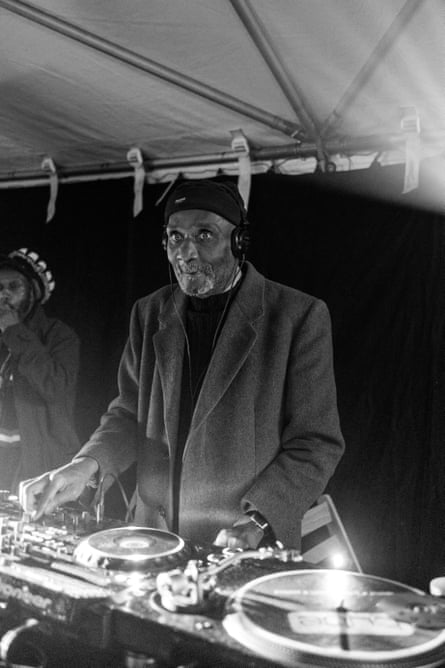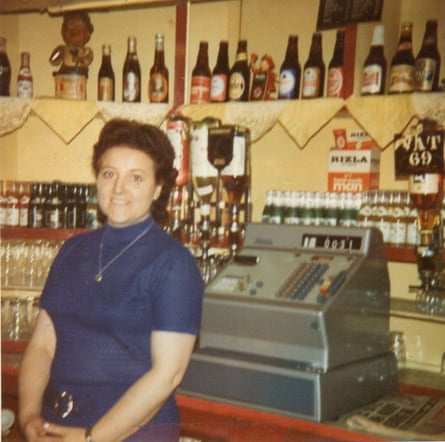“The police, the establishment and what felt like the whole world were against us,” recalls Alfonso “Fonzo” Buller, the son of a Belizean immigrant and a Romany Gypsy, who first tiptoed into Manchester’s Reno nightclub aged 12. “But the Reno was the one place where we could feel special.”
In its 1971-81 heyday, regulars at the Moss Side spot ranged from snooker champion Alex “Hurricane” Higgins to Factory Records boss Tony Wilson, while visitors included Muhammad Ali and, reputedly, Bob Marley. However, its unique role was as a haven for the city’s emerging mixed-race population.
The basement club was demolished in 1986, and a party at the excavated site has now brought together former Reno regulars, their children and even their children’s children, from all corners of the globe. There’s a big muddy hole where the dancefloor used to be, but three original DJs have been reunited in a large marquee to play music until daybreak. The legendary DJ Persian, who manned the decks here from 1968 to 1983, is now 74 and recovering from an operation. Now an internet radio broadcaster, he plays CDs because his vinyl box has become too heavy to carry, but promises: “When people hear these tunes, they will go wild.”

Jamaican-Irish playwright Linda Brogan had the idea of exhuming Manchester’s lost subculture when she paid an emotional visit to the place she spent many happy hours in her youth, to find nothing but grass and poppies. It took 18 months to secure Arts Council funding before she discovered that part of the club was inaccessible under the widened Princess Road. However, as the community dug with bare hands, they unearthed the kitchen, part of the dancefloor and items ranging from lipstick to a pair of flares. “Even some weed,” chuckles Brogan, “still in its plastic bag.”
People could openly smoke it in the Reno; veteran Manchester drummer Bruce Mitchell remembers his father trying to stop him playing there, “for my moral protection”. When police raided, doormen pressed a secret button to alert revellers below. “Then we’d hear the boots coming downstairs, so we’d all run for the back door with our weed,” chuckles Brogan. “There wasn’t much room out there so we’d all be on each other’s backs, laughing.”
She compares the Reno’s mirrored staircase and dim lighting to “the club scene in Goodfellas where Ray Liotta is showing off to his girlfriend”. Reno fashions ranged from karate gear to tracksuits. “Everyone looked wicked. Inside, it was happening.”
It had been struggling reggae/calypso club, the Palm Beach, until Persian (nicknamed after his youthful ability to move like a Persian cat) arrived from Jamaica and remodelled everything based on speakeasies he’d seen in the movies. “I wanted somewhere people could unwind after a hard day,” he explains. “Monday to Thursday I’d play relaxing music. Friday, Saturday, it became a discotheque. I played funk and soul and it just took off.”
Susie Prouse, whose parents frequented the Reno before she did, tells me how the club’s early African owners had brought their white girlfriends to the club, “so it became a place where a black man and a white woman could meet without the stigma they’d get elsewhere”. Later, when the mixed-race offspring of such couples were refused entry to other clubs, the Reno provided sanctuary from racism or harassment.

Fonzo had his dreadlocks forcibly cut off, while his friend Billy Marbell – at 67, in a beret, still a natty soul boy – remains hurt by his treatment by police despite “always being a grafter, a straight citizen. But I was treated like a piece of … you know.” Returning has brought happier memories. “A black person or a white person couldn’t understand how we felt, but the Reno was our own.”
Students flocked there after the club was mentioned in Manchester University’s prospectus, while after-hours drinking and dancing attracted actor Ray Winstone, cricketer Clive Lloyd, Happy Mondays’ Bez and a young Mick Hucknall, whose first single with Simply Red was a cover of the Valentine Brothers’ Money’s Too Tight (To Mention), which he could have heard in the Reno.

Marbell got Ali’s autograph in the doorway. “He pulled out a pad which read ‘Don’t forget!’ on top and signed it,” he smiles. “His handshake was superhuman, but he was approachable, a nice person.” Sadly, the rumoured Bob Marley visit remains unconfirmed, although Fonzo points out that in the 70s he bore an uncanny resemblance to the reggae star, “so it’s possible that people saw me”.
However, the Reno did receive a royal visit: the Queen regally waved towards regulars as her silver jubilee motorcade passed through Moss Side in 1977. “There were banners reading ‘Fuck the Queen’,” chuckles Dennis Mullings, who lived locally. “Officials ripped them down before she went past.”
Sadly, by the mid-80s, robberies were putting off students and the Reno had a violent visit from the emerging Cheetham Hillbillies gang, who later took guns into the Haçienda. However, the club’s demise was because of health and safety concerns. “A three-storey Victorian building with us lot underneath,” explains Susie Mousah, who came aged 17. “No fire escapes … it had to go.”
But here we are. It’s 4am, Persian is on the decks, rum punch flows and the excavation has triggered interest in the UK’s often forgotten mixed-race story. “Copper-coloured divine race!” cackles Fonzo, holding up the recovered pair of mud-spattered 70s bellbottoms. “We finally have a voice.”
- Follow the ongoing Excavating the Reno project at thereno.live

Comments (…)
Sign in or create your Guardian account to join the discussion